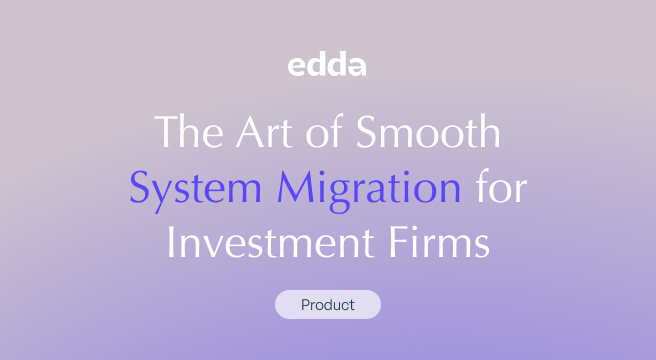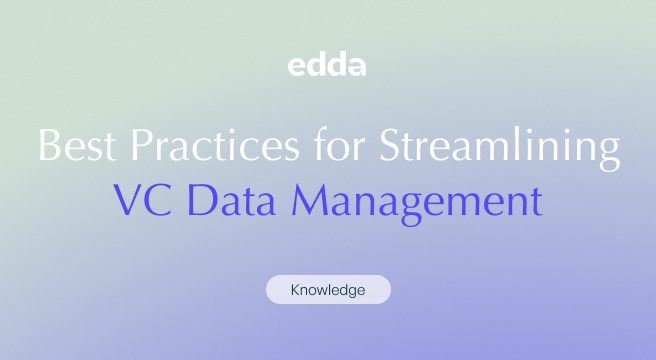Explore the essential fintech tools shaping investor strategies. From CRM for venture capital platforms to sophisticated pipeline and deal flow management software, and dynamic VC portfolio management software, our guide unravels how each component uniquely supports the venture capital ecosystem.
In this article, we outline the functionalities and advantages that these technologies offer to investors, enhancing their decision-making, operational efficiency, and investment outcomes. In addition, discover how Edda’s venture capital management software integrates these diverse tools into a unified platform for streamlined venture capital management.
Investor VC CRMs
Customer Relationship Management (CRM) platforms tailored for investors are specialized software systems designed to optimize the management of investor relations, deal flow, and portfolio companies.
These platforms cater specifically to the needs of investors by providing tools to efficiently track interactions with startups, manage investment opportunities, and analyze the performance of their portfolios.
Who needs it?
- Investment Managers to oversee deal pipelines and conduct due diligence.
- Partners to collaborate on investment decisions and track firm-wide engagements.
- Analysts to research potential investments and monitor market trends.
What are the key functionalities?
- Centralized databases for storing detailed information about startups, including founders’ details, funding rounds, and sector insights.
- Interaction tracking to log communications with potential and current investments, ensuring a comprehensive view of the relationship history.
- Deal flow management tools to categorize and prioritize investment opportunities, streamlining the evaluation process.
- Portfolio management features to monitor the growth and performance of invested companies, facilitating strategic follow-on investments.
- Automated workflows to manage tasks like scheduling meetings, setting reminders for follow-ups, and updating deal statuses.
Benefits of Investor CRMs
Implementing an investor CRM platform offers several advantages:
- Enhanced visibility into the investment pipeline, allowing VCs to make informed decisions and quickly respond to emerging opportunities.
- Improved relationship management with founders and co-investors, leading to stronger networks and potential collaborative ventures.
- Increased operational efficiency by automating routine tasks, enabling VCs to focus on strategic decision-making and value-added activities.
- Data-driven insights into portfolio performance, assisting in the identification of trends, risks, and opportunities for exits or additional investments.
For investors, CRM platforms are not just about managing customer relationships but are pivotal in managing the entire investment lifecycle, from initial contact with startups to exit strategies. These systems support investors in navigating the complex ecosystem of venture investing, ensuring they can maintain a competitive edge and maximize returns on their investments.
Deal Flow & Pipeline Management
Deal flow and pipeline management systems are integral components of the investment process, designed specifically to streamline the identification, tracking, and evaluation of potential investment opportunities.
These systems are crucial for investors looking to optimize their deal sourcing, due diligence, and investment decision processes.
Who needs it?
- Investment Managers to efficiently manage and monitor the flow of investment opportunities and lead the due diligence efforts.
- Partners for collaborative assessment and decision-making on potential deals, ensuring alignment with the firm’s investment strategy.
- Analysts to perform in-depth market analysis, competitive landscape assessment, and financial modeling for potential investments.
What are the key functionalities?
- Comprehensive Deal Databases: Systems provide robust databases to catalog extensive details on potential deals, including startup profiles, industry sectors, funding stages, and key financials.
- Dynamic Deal Tracking: Enable the tracking of each potential investment through various stages of the deal flow, from initial contact to investment decision, ensuring no opportunity is missed.
- Prioritization and Filtering: Advanced filtering capabilities allow investors to prioritize deals based on predefined criteria, focusing their efforts on the most promising opportunities.
- Collaborative Tools: Facilitate seamless collaboration among team members, allowing for shared notes, ratings, and comments on each deal, enhancing collective decision-making.
- Automated Alerts and Reminders: Automated systems for setting alerts on deal milestones and reminders for follow-ups, ensuring timely actions and engagements.
While similar to a CRM in functionality, dealflow CRM platforms are broader tools designed to enhance customer relationships and manage interactions across various business functions.
Advantages of Deal Flow Systems
- Streamlined Deal Sourcing: Enhances the efficiency of sourcing and evaluating new investment opportunities, saving valuable time and resources.
- Informed Investment Decisions: Consolidates all relevant deal information in one place, providing a solid foundation for making informed investment choices.
- Collaborative Evaluation: Promotes a cohesive approach to deal assessment, leveraging the collective expertise of the investment team.
- Strategic Portfolio Diversification: Aids in maintaining a balanced and strategically diversified investment portfolio by providing insights into the pipeline’s composition.
For investors, deal flow and pipeline management systems are critical for maintaining a competitive edge. By providing a structured and efficient approach to deal management, these systems play a pivotal role in enhancing the overall investment process, from discovery to decision-making, ensuring investors can capitalize on the best opportunities for growth and returns.
Portfolio Management Tools
Portfolio management tools are specialized software solutions designed to assist investors in overseeing and optimizing the performance of their investment portfolios. These tools are essential for maintaining a comprehensive view of investments, assessing their performance, and making informed decisions to maximize returns and mitigate risks.
Who needs it?
- Portfolio Managers to strategize and implement investment decisions based on real-time data and performance analytics.
- Financial Analysts for conducting in-depth analysis on portfolio holdings, market conditions, and potential investment opportunities.
- Risk Management Specialists to evaluate and manage the risk exposure of the portfolio, ensuring alignment with the investment firm’s risk tolerance.
What are the key functionalities?
- Real-time Performance Tracking: Enables monitoring of the current performance of portfolio holdings, including gains, losses, and overall valuation.
- Asset Allocation Visualization: Provides tools to view and adjust the asset distribution within the portfolio, ensuring diversification and alignment with investment goals.
- Risk Assessment Features: Incorporates risk analysis tools to evaluate the volatility and risk exposure of portfolio investments.
- Compliance Monitoring: Ensures that the portfolio adheres to regulatory requirements and investment mandates.
- Reporting and Analytics: Offers comprehensive reporting capabilities to generate detailed insights on portfolio performance, asset allocation, and risk metrics.
Advantages of Portfolio Management Tools
- Informed Decision-Making: Facilitates data-driven investment decisions by providing a holistic view of the portfolio’s performance and risk profile.
- Strategic Diversification: Aids in achieving an optimal balance of assets within the portfolio, enhancing potential returns while managing risk.
- Efficient Portfolio Monitoring: Streamlines the tracking and management of investments, saving time and reducing the likelihood of oversight.
- Enhanced Risk Management: Offers advanced tools for identifying and mitigating risks, ensuring the portfolio’s risk level remains within acceptable bounds.
Portfolio management tools are indispensable for investors seeking to maintain a strategic overview of their investments and optimize their portfolios for maximum performance.
By offering advanced analytics, real-time data, and strategic planning features, these tools empower investors to navigate the complexities of the financial markets effectively, ensuring their portfolios are well-positioned for growth and aligned with their investment objectives.
LP Portal
An LP (Limited Partner) Portal is a specialized online platform designed to facilitate communication and information sharing between investment firms and their limited partners. It serves as a secure and efficient conduit for providing LPs with real-time access to investment performance data, portfolio updates, and important documents related to their investments.
Who needs it?
- Investment Firms to transparently share performance data, reports, and updates with their LPs, enhancing trust and engagement.
- Limited Partners for direct access to their investment information, performance metrics, and to communicate with the investment management team.
What are the key functionalities?
- Performance Reporting: Provides LPs with detailed reports on the performance of their investments, including metrics like IRR (Internal Rate of Return) and TVPI (Total Value to Paid-In Capital).
- Document Sharing: Secure platform for sharing important documents such as capital call notices, distribution notices, and quarterly reports.
- Investment Updates: Facilitates the delivery of regular updates on portfolio companies, market insights, and strategic decisions by the fund.
- Capital Account Tracking: Allows LPs to view their capital commitments, contributions, distributions, and the current value of their investments.
- Secure Communication: Offers a secure channel for LPs to communicate with the investment team, ask questions, and provide feedback.
Advantages of LP Portals
- Enhanced Transparency: Ensures that LPs have a clear and up-to-date understanding of their investment performance and fund activities.
- Improved LP Satisfaction: By providing easy access to information and a direct line of communication, LP portals contribute to higher LP engagement and satisfaction.
- Operational Efficiency: Reduces the administrative burden on investment firms by automating the distribution of reports and updates, streamlining investor relations tasks.
- Data Security: Implements robust security measures to protect sensitive investment information and LP data.
LP Portals are crucial for maintaining an open and transparent relationship between investment firms and their limited partners, ensuring that LPs are well-informed and engaged with the performance and management of their investments.
By leveraging LP Portals, investment firms can enhance LP satisfaction, improve communication efficiency, and uphold the highest standards of data security and transparency.
Unified Investment Management with Edda: Streamlining VC Operations
CRM platforms, deal flow and pipeline management systems, and portfolio management tools each address different aspects of venture capital operations.
Edda’s venture capital deal flow management software unifies these functionalities, providing a singular platform for managing relationships, tracking investment opportunities, and analyzing portfolio performance. This comprehensive approach streamlines the investment process, offering venture capitalists an integrated solution to enhance efficiency and decision-making.
Discover the seamless integration of relationship management, deal tracking, and portfolio oversight with Edda. Elevate your investment strategy—schedule your Edda demo today.




